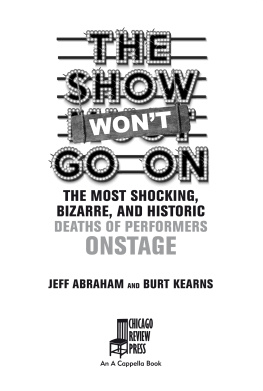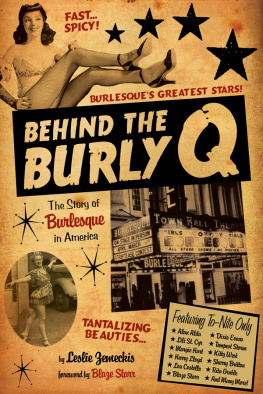Sommaire
Pagination de l'dition papier
Guide
Jeff Abraham
To my amazing mother and father, who inspired me in so many ways. I am a better person today because of them!
Burt Kearns
For Alison, Sam, Sally Jade... and Brian. Prima la famiglia.
Copyright 2019 by Jeff Abraham and Burt Kearns
All rights reserved
Published by Chicago Review Press Incorporated
814 North Franklin Street
Chicago, Illinois 60610
ISBN 978-1-64160-220-4
Library of Congress Cataloging-in-Publication Data
Names: Abraham, Jeff, 1962 author. | Kearns, Burt, author.
Title: The show wont go on : the most shocking, bizarre, and historic
deaths of performers onstage / Jeff Abraham and Burt Kearns.
Description: Chicago : Chicago Review Press Incorporated, 2019. | Includes
index. | Summary: The first comprehensive look at a bizarre show
business phenomenon: the actors, singers, musicians, magicians,
comedians, and others who died while performing onstage Provided by publisher.
Identifiers: LCCN 2019011885 (print) | LCCN 2019980914 (ebook) | ISBN
9781641602174 (trade paperback) | ISBN 9781641602181 (pdf) | ISBN
9781641602198 (kindle edition) | ISBN 9781641602204 (epub)
Subjects: LCSH: EntertainersBiography. | EntertainersDeath.
Classification: LCC PN2205 .A37 2019 (print) | LCC PN2205 (ebook) | DDC
791.0922 [B]dc23
LC record available at https://lccn.loc.gov/2019011885
LC ebook record available at https://lccn.loc.gov/2019980914
Cover design: Preston Pisellini
Typesetting: Nord Compo
Printed in the United States of America
5 4 3 2 1
This digital document has been produced by Nord Compo.
Prologue
THIS PROJECT BEGAN WITH AN Elvis Presley tribute concert in 2004. Elviss announcer, Al Dvorin, the man whod say, Elvis has left the building at the end of shows back when Elvis was alive, spoke the phrase into a microphone after the performance by Elvis impersonator Paul Casey. Al got a standing ovation, then signed autographs in the lobby. One of us was there at the Trump 29 Casino in Coachella, California, that night, when some fan suggested to Al that he write his autobiography. I know, I keep putting it off, Al replied. But I will one day. I have time. He set off for home in Las Vegas the next morning, only to be killed in a car crash in the desert.
This unfortunate Elvis-related event led to a discussion that turned into an exploration that was even more ambitious and unwieldy than the one youre about to read. It was a study of performers who died after a show. These were the show people who took their bows, wiped off the greasepaint, put on their top hats, and made it to the car or plane or back to the hotel roomand then, like poor Al Dvorin, wound up leaving the building. Next came an accounting of the troupers who didnt quite make it to the stage or set, because death stuck out its bony foot and tripped them up along the way.
That exploration became an investigation that landed on an even more surprising and devastating show business phenomenon that has gone, for the most part, unexamined until now: the ones who died onstage, while performing.
The investigation took us to Broadway shows, nightclubs, dinner theaters, amphitheaters, playhouses, arenas, concert halls, auditoriums, studios, tents, movie sets, and televised events and introduced us to an illustrious group that includes actors, singers, musicians, magicians, comedians, deejays, chorus girls, models, journeymen, and social media starspeople who are remembered as much for the way they left the building as for what they did inside. (We didnt include athletes, fighters, toreadors, race car drivers, or others who enter the field, arena, or ring, accepting that death is always a potential outcome.)
Initially, we chronicled every recorded death of a performer onstage. Our research led to hundreds of incidents, dating back centuries, and a project that turned out to be more comprehensive than any study previously attempted. Urban legends were debunked, long-held assumptions contradicted, Wikipedia-style misinformation corrected, new details from well-known stories unearthed, and the obscure stood (or were laid) shoulder to shoulder with the legendary. As the work continued and the pages flew from the calendar, however, we discovered a phenomenon just as compelling and even more frustrating: performers keep dying onstage. Every month or so, a singer would collapse mid-song, an act of violence would shatter the tranquility of a recital, or one of the new breed of social media personalities would expire live on camera before millions of fans. The number of performers who die onstage is always growing, too many and too often to be contained within the pages of a single volume.
So we boiled it down to the onstage deaths that really stood out among the rest. These are performers who died in front of an audience, grouped roughly into the categories of their specialties, with nods to additional related onstage passings that bring the total well into the three-figure range. These are our picks. The reader can debate if others deserve equal attention.
To die onstageis it a curse? Could it be a gift? Is there any consolation in knowing that these performers died doing what they loved? And was it really the way theyd have wanted to go? Some answers, and much more, will be found in the pages to follow.
The Guinness
World Record
Jane Little
Jane Little stood four feet, eleven inches tall and weighed less than a hundred pounds. Yet she played the double bass, the largest instrument in the Atlanta Symphony Orchestra, and one that stood a good foot taller than she did.
She was Jane Findley and sixteen years old when she joined the Atlanta Youth Symphony Orchestra in 1945. She made her debut that February 4 wearing a pastel evening gown, and she remained with the group when it began to admit adults and grew into the Atlanta Symphony.
Jane married the symphonys principal flutist in 1953. Warren Little was six foot two and would carry his little flute and her big bass. Even after he retired, hed drive her to and from Atlanta Symphony Hall in their big baby-blue Chevrolet Caprice Classic station wagon. During her career, Jane played for conductors such as Igor Stravinsky, Leopold Stokowski, Aaron Copland, and James Levine. In 1996 she performed at the opening and closing ceremonies of the Atlanta Summer Olympics with conductor John Williams.
The highlight of her symphonic career came on February 4, 2016, two days after she celebrated her eighty-seventh birthday. Jane wasnt in the best of health that day. Shed been undergoing chemotherapy treatment for multiple myeloma and had suffered a cracked vertebra the previous August, but after months of rehabilitation she was ready to play the double bass once more. The Washington Post reported on the occasion: On Monday, Jane Little got her weekly chemo shot. Thursday, she gulped down five green steroid pills and reported to Symphony Hall to fight her way back to the stage. And that she did, all 98 pounds of her, stroking a D chord at 8:04 p.m. to make her comeback official.
With that stroke of the bow, Jane Little became holder of the Guinness World Record as the musician with the longest tenure with an orchestra. With seventy-one years, she passed the record set by Frances Darger, the violinist whod retired in 2012 after seventy years with the Utah Symphony. Indeed, the prospect of taking the title was one reason Jane decided to return to the symphony for one last season, despite serious illness and injuries.
Id thumb through the Guinness book and say, Wouldnt it be neat? she told the Post. A lot of people do crazy things like sitting on a flagpole for three days. I just kept on. It was just me and the lady in Utah. So finally, I said, Im going to do this.










